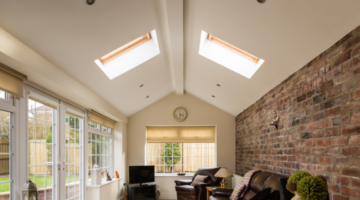
We are often asked whether we would recommend underfloor heating or infrared panels, especially in regards to bathrooms. They are very different technologies, and the bottom line is that it depends if you are doing it just for comfort, or you would like to take running costs into account too!
What is underfloor heating?
Underfloor heating can be either ‘wet’ or ‘dry’. To explain it very simply, these systems spread heat through the floor surface, either via pumping warm water through pipes under the floor, or generating heat via electric coils. The idea is that the heat rises and warms the whole room, as opposed to heating from the sides of the room with radiators. It is a popular choice for bathrooms because it has the benefit of warming your feet, in an area of the house where the floor is normally uncarpeted, and can be chilly as a result!

Installing underfloor heating
Having underfloor heating put in is not a particularly quick job, and can it be pretty inconvenient. Depending which type you opt for, it normally takes between a few days and a week to install, and in this time, you won’t be able to use the room! If you have decided to install underfloor heating on a ground floor (and depending on the system), it may be necessary to excavate downwards and then re-lay the floor. If you’re installing it upstairs, the increased floor height might mean you need to raise the doors and skirting boards. Installation starts from around £75 per square metre, depending on the system you choose and the construction of the room.
Infrared benefits over underfloor heating
- Much cheaper to purchase and install. A lower-wattage infrared system will cost roughly half as much to install as an underfloor heating system providing a comparable level of heat.
- Cheaper to run. This is because infrared heats via radiation, so is more targeted – heat is not lost through draughts.
- Targets heat at you directly, as well as the building fabric and contents. If place panels on the ceiling, they will heat the floor, and everything else too!
- Doesn’t create a stuffy atmosphere.
- Penetrates walls, floor and other surfaces, and helps dry them out.
- If all goes to plan, there should be very little maintenance.
- Far easier to install – not disruptive to the household.
- Heat remains in walls and furniture (thermal mass) and continues to radiate once the heaters are turned off. Heat is more easily lost with underfloor heating, which works mainly through convection and is therefore susceptible to draughts.
Hope this has given you a starting point for deciding which option to go for! Basically, underfloor heating should be installed as a luxury, rather than an energy saving measure. It probably won’t pay for itself in savings to your heating bills but it will keep your feet warm! Infrared, however, is a comfortable heating source, and a more efficient option. It will also help dry out your bathroom and discourage the formation of damp!












I’m considering installing an infrared panel on my kitchen ceiling (8ft high). My floor has porcelain tiles and i’m wondering if the panel will heat these floor tiles effectively.
I had exactly the same idea, did you ever install the panel and did it work?
HI
I am having an extension on ground floor -approx 32msq; planning to have tiles; how much would it cost for approx 50msq to have infrared heating? is it on the floor /ceiling?
Hi R,
Without more information I’ll have to be quite general and say that the 50 square metre space would need between 3,250 – 5,000w of energy total. Presuming that the extension is being build with good insulation, it is likely to be at the lower end of this estimate, however there are many factors that can effect it.
As for cost, it very much depends on the type and brand of panels you’d like to invest in.
My suggestion would be for you to give us a call, or fill in one of our contact forms and allow us to get our expert local installer partners to give you a call directly.
Many thanks,
Harriet